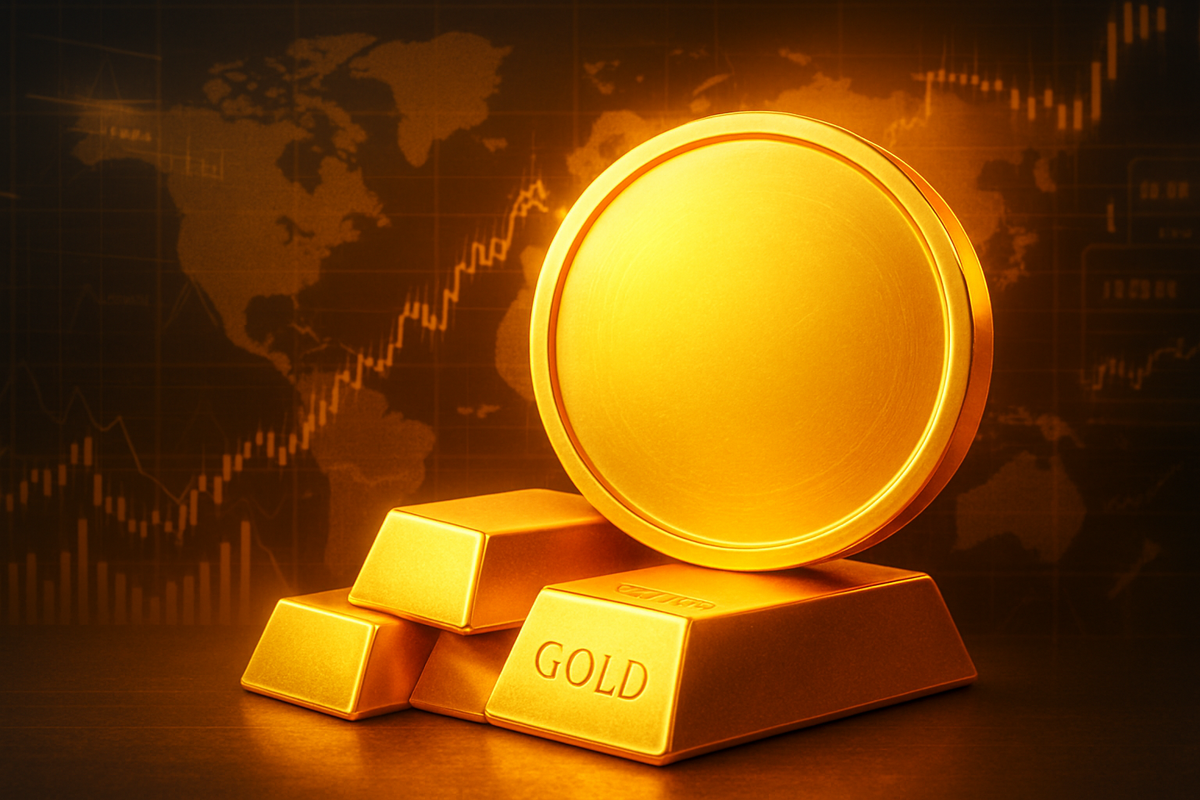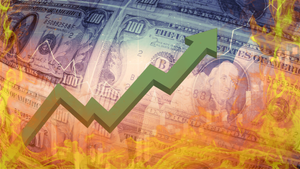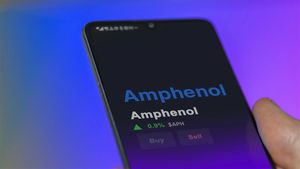
Gold prices have surged to unprecedented levels, breaking decisively above the $4,000 per ounce mark and establishing new record highs as of October 8, 2025. This historic rally signifies a profound recalibration in global financial markets, reflecting deep-seated anxieties about economic stability, geopolitical order, and the long-term integrity of traditional fiat currencies. The yellow metal's ascent is not merely a fleeting moment but a culmination of several powerful, interconnected factors that are reshaping the financial landscape, prompting investors and central banks alike to flock to its traditional safe-haven appeal.
The immediate implications are far-reaching, signaling an intensified safe-haven appeal as investors seek secure stores of wealth amidst heightened global uncertainty. This surge underscores growing concerns about the U.S. dollar's integrity, with many viewing gold as a crucial "debasement trade" against potential currency devaluation. Central banks globally are aggressively increasing their gold reserves, further solidifying its role as a strategic asset for diversification. While the rally promises significant gains for some, it also introduces market volatility and calls for caution, as the rapid ascent pushes technical indicators into "extreme overbought levels."
A Historic Ascent: Gold's Journey Beyond $4,000
The current gold price rally is nothing short of remarkable, with spot gold breaching the $4,000 mark for the first time, trading at approximately $4,035 early on Wednesday morning, October 8, 2025. Gold futures also reached an all-time high of $4,014 per ounce on Tuesday morning, with some reports indicating spot prices as high as $4,049.59 per ounce. This signifies a substantial increase, with gold futures appreciating by about 50% since the beginning of 2025, following a 27% rise in 2024 and 13% in 2023.
This unprecedented surge is driven by a "toxic cocktail of pressures." A prolonged U.S. government shutdown, now in its second week, has fueled concerns over fiscal stability and global risk aversion. The Federal Reserve's pivot to a rate-cutting cycle through 2025 has created a favorable environment for non-yielding assets, decreasing the opportunity cost of holding gold. Geopolitical instability, including ongoing conflicts in Ukraine and Gaza, alongside political uncertainties in France and Japan, continues to drive a flight to safety. Furthermore, unprecedented central bank purchasing, especially in emerging markets, underscores a strategic shift away from dollar-denominated assets, while a weakening U.S. dollar makes gold cheaper for international buyers. Lingering inflation concerns and a "fear of missing out" (FOMO) among investors have also contributed to the buying frenzy.
Key players in this rally include global central banks, particularly those in emerging markets, who are diversifying their reserves. Billionaire investors like Ray Dalio have advocated for significant gold allocations in portfolios, influencing broader investor sentiment. Gold-backed Exchange-Traded Funds (ETFs) such as SPDR Gold Shares (NYSEARCA: GLD) and iShares Gold Trust (NYSEARCA: IAU) have seen record inflows, indicating strong retail and institutional interest. Initial market reactions have been characterized by a scramble for safe-haven assets, with other precious metals like silver also experiencing significant percentage jumps, and a cautious optimism mixed with warnings of overbought conditions.
Corporate Fortunes: Winners and Losers in a $4,000+ Gold Market
A sustained rally in gold prices above $4,000 per ounce would have a profound and varied impact on public companies across several sectors.
Gold Mining Companies are the clearest beneficiaries. With all-in sustaining costs (AISC) for many producers ranging from $1,089 to $1,298 per ounce, a gold price above $4,000 generates exceptional profit margins of 60-67%. This translates to increased revenue, stronger balance sheets, robust cash flow, and potential for higher shareholder returns through dividends and buybacks. Major players like Newmont Corporation (NYSE: NEM), the world's largest gold producer, and Barrick Gold Corporation (NYSE: GOLD), a global mining giant, are exceptionally well-positioned to capitalize on these elevated prices. Other low-cost producers such as Agnico Eagle Mines Limited (NYSE: AEM) and smaller miners like Coeur Mining Inc. (NYSE: CDE), Hecla Mining Co. (NYSE: HL), and McEwen Inc. (NYSE: MUX) also stand to gain significantly. Gold streamers and royalty companies, such as Royal Gold Inc. (NASDAQ: RGLD), which acquire precious metals through long-term contracts, benefit directly from higher prices with reduced operational risks.
Precious Metals ETFs are also clear winners. Funds like SPDR Gold Shares (NYSEARCA: GLD) and iShares Gold Trust (NYSEARCA: IAU), which hold physical gold, directly reflect the price movements. ETFs that invest in gold mining stocks, such as the VanEck Gold Miners ETF (NYSEARCA: GDX), offer leveraged exposure to the sector's increased profitability.
Conversely, the impact on Jewelers is more complex and often negative for mass-market retailers. Higher gold prices directly translate to increased raw material costs, squeezing profit margins if these cannot be passed on. This can also stifle consumer demand for gold jewelry, leading to reduced sales volumes. Signet Jewelers Limited (NYSE: SIG), operating mass-market brands like Kay Jewelers and Zales, is particularly vulnerable to these pressures. While luxury brands like Tiffany & Co. (owned by LVMH Moët Hennessy Louis Vuitton) may possess greater pricing power, the broader jewelry sector faces headwinds. Industrial users of gold, such as the electronics and nanotechnology sectors, would also face increased raw material costs, potentially impacting their margins.
Broader Implications: A Shifting Financial Landscape
Gold's surge past $4,000 per ounce is more than a mere commodity price milestone; it serves as a potent bellwether for global economic sentiment and market anxieties. It indicates a deep lack of confidence in the stability of traditional financial systems and governmental efficacy, particularly amplified by events like the ongoing U.S. government shutdown and political instability in other major economies. This surge reflects a collective reappraisal of trust, sovereignty, and what constitutes a "safe" asset in an increasingly uncertain world.
This rally fits into several significant broader industry trends: intensifying geopolitical risks, persistent economic uncertainty and inflation concerns, central bank monetary policy shifts (especially the Fed's pivot to rate cuts), and unprecedented central bank gold buying. A weakening U.S. dollar, driven by a dovish Fed and political instability, further boosts gold's appeal. The "debasement trade," where investors hedge against waning faith in the U.S. dollar and Treasuries, is a significant underlying theme, signaling a deeper structural shift towards an "age of fiscal dominance."
The ripple effects are extensive. Other precious metals like silver have mirrored gold's rally, surging to a 14-year high. While equities may see rotation out of riskier assets, an unusual trend is the simultaneous record highs in both gold and the S&P 500, suggesting abundant market liquidity. U.S. Treasuries become less attractive, pushing investors towards gold. The U.S. dollar is under pressure, and aggressive central bank diversification signals a broader strategic shift in global reserve asset allocation. Regulatory implications include potential calls for more aggressive inflation management, enhanced regulation of gold markets, and heightened pressure on policymakers to address fiscal imbalances. Historically, this rally shares similarities with the 1970s inflationary period and the post-2008 financial crisis, driven by inflation, geopolitical tensions, and monetary uncertainty, but with unique dynamics like simultaneous record highs in gold and equities.
What Comes Next: Navigating the Golden Future
In the short term, gold markets are likely to experience a mix of continued bullish momentum and potential for tactical pullbacks. Analysts are identifying near-term resistance levels around $4,100, $4,200, and $4,300 per ounce, suggesting room for further upward movement. However, periods of profit-taking leading to short-term corrections of 5-10% are possible, though "dip-buyers" are expected to emerge, treating drops as buying opportunities.
The long-term outlook for gold remains predominantly bullish. Goldman Sachs has revised its year-end 2026 forecast to $4,900 per ounce, with some projections even suggesting $5,000+ by 2027. Sustained geopolitical instability, persistent inflationary pressures, continued U.S. dollar weakness, and aggressive central bank demand are expected to underpin gold's value. The weakening correlation between gold and U.S. real yields suggests that political, fiscal, and strategic considerations are now exerting greater influence.
Strategic pivots are required across market participants. Investors are advised to maintain a long-term outlook, treating gold as a strategic asset for diversification, with some suggesting a 15% portfolio allocation. Diversification through gold-backed ETFs and quality gold mining equities is also recommended. Miners, facing a favorable environment, may pursue increased exploration and project acceleration, while central banks are expected to continue their gold accumulation strategies as a long-term economic diversification plan. Emerging markets present both opportunities through central bank demand and challenges due to affordability and import costs for gold. Potential scenarios range from a sustained bullish rally towards $4,900 and beyond, to a moderate consolidation phase, or a less likely significant correction if key risk factors reverse.
Comprehensive Wrap-up: Gold's Enduring Legacy
Gold's breach of the $4,000 threshold is a historic event, solidifying its role not just as a crisis hedge but as a fundamental component of strategic asset allocation for both institutional and individual investors. The key takeaways include an unprecedented surge driven by safe-haven demand, a weakening U.S. dollar, expectations of rate cuts, and aggressive central bank buying. This rally underscores gold's traditional role as an inflation hedge and a store of value, evolving it into an "asset for all occasions."
Moving forward, the market is assessed to remain broadly constructive, with many experts forecasting continued upward momentum, potentially towards $4,900 and beyond. However, investors must remain vigilant to market volatility and potential corrections. The lasting impact of gold at these record highs could be a fundamental recalibration of how major world economies and investors perceive and utilize gold within their portfolios, elevating it from a peripheral "insurance" asset to a more central, strategic holding. This suggests a potential long-term structural bull market for gold.
Investors should closely monitor several key indicators in the coming months: Federal Reserve monetary policy, ongoing geopolitical developments, inflation trends and economic data, U.S. dollar strength, central bank buying trends, and ETF flows. Technical indicators will also be crucial for gauging short-term market sentiment.
Disclaimer: This content is for informational purposes only and is not financial advice. Investing in any asset carries risks, and past performance is not indicative of future results. Always consult with a qualified financial advisor before making any investment decisions.







